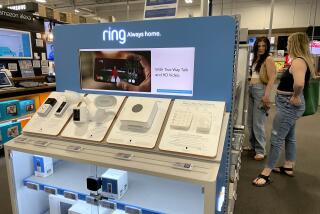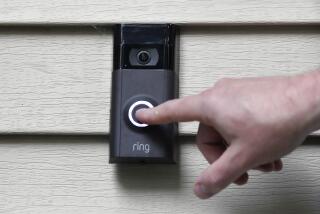VIDEO AND AUDIO MARCH PROMISINGLY INTO ’87
- Share via
As Times Arts Editor Charles Champlin noted in Sunday’s Calendar, 1986 was the year when we began to take VCRs for granted. In addition, we probably started taking a lot of other Home Tech wonders for granted, too: compact discs, an avalanche of audio-visual accessories, and the attachment of digital to everything but the kitchen sink (which perhaps is destined to wear the tag as well--digital hot water, anyone?).
Despite its conquests, technology marches on--for better or worse--and here are some of the developments that 1987 should bring:
--A trying time for eight-millimeter. The eight-millimeter video format didn’t challenge VHS to the degree predicted by many early in 1986, but Sony-backed, relatively miniature 8mm appeared to get a foot in the door thanks to early consumer response to the 8mm camcorder (camera-recorder).
There could be further penetration into the market in ‘87--a crucial year for the format--but it may not be enough to ensure 8mm’s survival, let alone assure its eventual dominance. Much will depend on how long it takes for video companies to release a substantial number of prerecorded videocassettes in the format, and how many video stores stock them. Another factor: the sales performance of several new 8mm home VCRs bowing during the year as more people buy second decks.
--Four-play. Korean manufacturer Samsung hopes to market a four-millimeter camcorder by late next year. That’s right-- four , not eight.
The prototype weighs 2 1/2 pounds. There are some intriguing aspects to the Samsung innovation. For one thing, it will use digital audio tape (80 minutes per reel)--which means the camcorder may be delayed if the U.S. introduction of consumer-format DAT is held up (see “Copycats” below). For another thing, the 4mm model receives TV signals, which means it could record “Miami Vice” as well as Miami vacations.
--Bye bye Beta. Every indicator points to the further slipping of the Beta videotape format’s market share, despite Beta’s quality edge over dominant VHS. It’s getting harder all the time to find Beta prerecorded tapes at video stores, and RCA/Columbia recently joined CBS/Fox in offering those stores limited format-for-format trade-ins so that they can replace their Beta stock with VHS tapes of the same titles.
--LV lives. On the other hand, LaserVision videodisc players may make a comeback over the next several months. The trade publication Video Week reports that imports of the machines rose 366.6% in October, the latest month measured--and that figure doesn’t even count combination CD/LV models (see next item).
--Tapes will take a hike. The more expensive prerecorded cassettes will cost even more. Beginning in late February, when CBS/Fox releases “Aliens” at a suggested list price of $89.98, several video producer/distributors are expected to raise prices of their high-end product. Increases at this price level should average between $5 and $15. For the time being, it doesn’t look as though lower-tagged tapes (in the $20- to $25-range) will be affected. But rental prices probably will.
--CD’s bright future. Compact disc players should continue to surge in ’87. Not only will music lovers keep on buying the relatively inexpensive low-end models, but a lot of the first-wave CD fans will be trading in their original players for either CD changers (that “stack” and play several CDs) or for models that play both CDs and Laserdiscs.
As for the compact discs themselves, there’s no sign that prices will go down much. They may even go up a bit. As the little silver-colored platters make a further incursion on the black-vinyl ones at your local record store, watch for the flack to fly over ever-more-limited LP selection. On the other hand, an increased number of unusual recordings will show up on CD.
Look, too, for further developments in the use of the CD format (especially in relation to video) and greater public awareness of CD capabilities, such as the storage possibilities of the computer-oriented CD-ROM discs.
--The people’s choice. While technological advances may mean a temporary shrinking of titles in record stores, the trend should continue to go in the opposite direction in video. More consumers will become aware of all the videos available that aren’t movies--with special attention to videotapes that teach skills. The mail-order video business will benefit most, but the selection at video stores should get better throughout ‘87, too.
--Digital VCRs. The big buzzword in consumer electronics during ’86 was “digital,” and don’t count on it fading from use anytime soon. The term will spread most notably to VCRs, where there will be increased application of digital technology--particularly in terms of picture improvement and built-in processing (tricks like polarization)--though so far “digital VCR” has chiefly meant special effects like picture-within-picture.
--Copycats. As much controversy as there was in ’86 over copying tapes (both audio and video), look for even more in ’87. There are some major questions to resolve: whether audio tape buyers will pay a surcharge that will go to record companies and artists to make up for home taping of records . . . whether Japanese manufacturers of digital audio tape machines will install antiduplication devices--and how much longer the battle over this issue will delay the introduction of DAT to America (latest estimated time of arrival, even if all goes well: summer) . . . and, on the video front, whether prerecorded-videocassette companies that have adopted the Macrovision antiduplication system will continue to use the method.
--Due process. A new breed of sound processors was introduced in 1986, but with most of them costing $500 and doing fairly non-essential tricks like adding reverberation, they may have a tough time at the marketplace. Video processors--capable of all sorts of picture manipulation but generally limited so far to the real video enthusiasts--should become popular with other VCR owners too.
--Tweeter and woofer boom. Speakers should be one of the year’s hottest-selling items, because a lot of people will not only want better speakers to get the most out of their CDs, but also to hear TV in stereo when they get MTS (stereo decoding) equipped monitors or VCRs.
--The dark side. Amid all the high-tech advancements, people will still buy stereo VCRs thinking they’re getting hi-fi, order remote control for everything under the sun, deliriously desire whatever new innovation they don’t have, throw tantrums when these new machines don’t work exactly as they’re expected to, and sadly ponder (often justly) what has been lost in order to make way for new toys.
Face it, in 1987--hard to imagine as it is--those lucky ones of us able to afford this Home Tech gear will be even more spoiled than we were in ’86. Happy New Year, anyway.
More to Read
The biggest entertainment stories
Get our big stories about Hollywood, film, television, music, arts, culture and more right in your inbox as soon as they publish.
You may occasionally receive promotional content from the Los Angeles Times.










